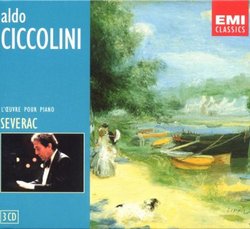| All Artists: Severac Title: Severac: Piano Works Members Wishing: 0 Total Copies: 0 Label: EMI Classics France Original Release Date: 1/1/2005 Re-Release Date: 8/5/2002 Album Type: Import Genre: Classical Style: Number of Discs: 3 SwapaCD Credits: 3 UPC: 724357237222 |
Search - Severac :: Severac: Piano Works
 | Severac Severac: Piano Works Genre: Classical
|
Larger Image |
CD Details |
CD ReviewsSomewhat variable (but excellently played) collection, but c G.D. | Norway | 11/28/2009 (4 out of 5 stars) "Déodat de Séverac spent most of his life in, and assumed it as his mission to recreate in music the spirit of, his native Céret. He was thus sort of an outsider to musical life in France, being rather fully integrated in village life and composing only when he felt like doing so; his oeuvre is thus rather small, but usually carefully considered, utilizing the smells and sounds and colors of nature and his surroundings and setting above all else music's ability to evoke extra-musical feelings and impressions. This set of his (not quite) complete piano music is very welcome, especially in performances as convincing as these, although I suspect most people would be happy enough with just the first disc, containing his most famous works, En Languedoc and Cerdaña.
En Languedoc is a set of five pieces written in an individual style redolent, perhaps, of Albeniz and early Ravel; poetic and dreamlike and apparently always grasping at misty, fleeting impressions. The first and last pieces, Vers le mas en fête and Jour de foire are thus sepia-tinged evocations of childhood, and the brief reminiscences of innocent play also characterizes the third piece, à cheval dans la praire. Preceding that is Sur l'étang, le soir with its intangible, distant noises. The penultimate piece, Coin de cimetière au printemps is a subtle mourning melody portraying inner, seemingly half-forgotten grief and emotional torment. Cerdaña, 5 etudes pittoresques, is (deservedly) Severac's most famous cycle, a variegated and colorful and thoroughly inspired collection, inspired by folk-themes and reminiscent of Albeniz's Iberia. The effective En tartane sets the scene and the poetic array of colors that is Les fêtes is rather striking; the form and subtle but ingenious interweaving of themes makes Ménétriers et glaneuses perhaps the most interesting of the pieces, but the musical sobriety of Les Muletiers devant le Christ de Livia makes for an effective contrast. The finale, Le Retour des muletiers, is a rhapsodic, atmospheric and lively piece and an apt conclusion to a very rewarding cycle. The music on the second disc might not be of the same quality, but the relatively early Chant de la terre (1901) is an attractive cycle of seven impressionistic paintings of country life that in the end owes more to d'Indy than to Debussy. Baigneuses au soleil and Les Naiades et le faune indiscret are overall more interesting - these are, again, vividly pictorial pieces, but the craftsmanship is stronger than in the earlier cycle, and the results might certainly be worthy of occasional airings. The disc is filled out with three occasional works of dubious merit, although the somewhat Satiesque Le Soldat de plomb might be worth hearing, if only once. The third disc opens with the two cycles of En vacances, the second of which was left incomplete (and completed by Blanche Selva). They seem to try to recreate the atmosphere of Cerdaña, but these pieces are unfortunately of far less interest - lightweight and intermittently charming but featuring nothing to remember them by. After an inconsequential Valse romantique the disc ends with something more interesting, however; Sous les lauriers roses is an ambitiously scaled, imaginative but episodic set of rhythmic variations, but with the musical material creatively and colorfully imitating various extra-musical sounds. In the end, though, I suspect it works mostly because it doesn't take itself too seriously. The performances are, of course, superb - I haven't heard to many other advocates of Severac's piano music, but I have a hard time believing they could surpass Ciccolini, with his unerring ability to bring color, life and character to each individual piece (even the less interesting ones). Sound quality is good as well, and the set can be safely recommended, although I suspect most people might do just fine with a one-disc selection of Severac's most famous works." |

 Track Listings (10) - Disc #1
Track Listings (10) - Disc #1